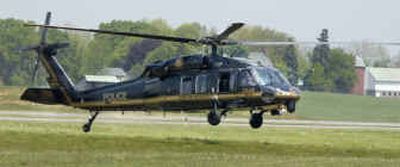Report: FAA plans to revoke license of pilot who caused scare

WASHINGTON – The pilot who caused a midday panic in Washington on Wednesday failed to get briefings about the weather and restricted airspace and became lost minutes after leaving a Pennsylvania airport, Federal Aviation Administration records show.
Hayden “Jim” Sheaffer, 69, froze when he saw a Black Hawk helicopter appear on his right wing while flying toward the White House and had difficulty operating his small, single-engine aircraft, officials said Friday. It took the valiant effort of Sheaffer’s student-pilot companion, Troy Martin, who had only logged 30 hours of flight time, to take over the controls and land the plane at an airport in Frederick, Md., officials said.
The FAA plans to take the most extreme action against a pilot since new airspace rules were put in place in 2003 and will revoke Sheaffer’s pilot certificate, according to aviation officials who spoke on condition of anonymity because the order had not been finalized. The FAA does not plan to take similar action against Martin, 36, because he is a student pilot and does not have a pilot certificate, sources said.
New details are emerging about what took place in the cockpit of the Cessna turboprop during the noontime drama that led to the evacuation of more than 35,000 people from the U.S. Capitol, White House and Supreme Court. A log prepared by federal security officials shows how tensions escalated to the point where a fighter jet was “about to use missiles” to shoot the plane down.
If Sheaffer ever plans to fly again, he will have to start over with flight school lessons. Those lessons cannot begin until a year after the revocation order. “Our investigation is ongoing,” FAA spokesman Greg Martin said.
Sheaffer and Troy Martin have been unavailable for comment since federal authorities released them Wednesday. They were forced down about 90 minutes after they took off from an airport in Smoketown, Pa., near Lancaster, headed for an air show in Lumberton, N.C.
The FAA is planning to cite Sheaffer for “careless or reckless manner so as to endanger the life or property of another,” records obtained by the Washington Post show. Sheaffer may appeal the revocation with the National Transportation Safety Board.
Within hours of the scare, authorities said the pilots were lost and disoriented. But the account provided in FAA documents casts Martin in a different light.
“It shows a tremendous presence of mind to be able to take the training he had and, under a very stressful situation, to bring that aircraft to Frederick,” said Chris Dancy, spokesman for the Aircraft Owners and Pilots Association, a group representing private pilots.
Dancy said Martin was probably about halfway through his student training, as most student pilots take about 60 to 75 hours to earn their certificate. Dancy said he would not expect the FAA to discipline Martin because Sheaffer was the only certified pilot onboard and therefore assumes responsibility for the aircraft.
FAA records indicate that Sheaffer failed to take the most basic steps that are required of pilots before operating an aircraft. He did not check the weather report before he left Smoketown and failed to check FAA’s “Notices to Airmen,” which serve as the agency’s required pre-departure reading for pilots to alert them of airspace restrictions. Had Sheaffer checked the notices, he would have realized that the 2,000-square-mile area around Washington is known as the Air Defense Identification Zone.
Sheaffer became lost soon after departure, records show. The documents show that he also failed to communicate with the FAA and provide necessary navigation information to ensure the safety of the flight.
The Cessna 150 crossed through three layers of increasingly restricted air space. The first area, known as the Air Defense Identification Zone, covers the overlapping 30-mile radii of the Washington area’s three major airports. The second, known as the Flight Restricted Zone, covers a 16-mile area around the Washington Monument.
Once intercepted by the Black Hawk and minutes away from flying over sensitive landmarks in the city, Sheaffer told investigators that he thought he had mistakenly flown over Camp David, another restricted airspace known as Prohibited Area P-40, FAA records show.
The FAA also said that Sheaffer was unaware of intercept procedures and did not know how to respond once he saw the Black Hawk, police jet and two F-16s. The F-16s flew by several times, both of them dropping flares to get his attention.
The most dangerous breach occurred when Sheaffer crossed into Prohibited Area P-56, no-fly airspace covering the White House and the Naval Observatory.